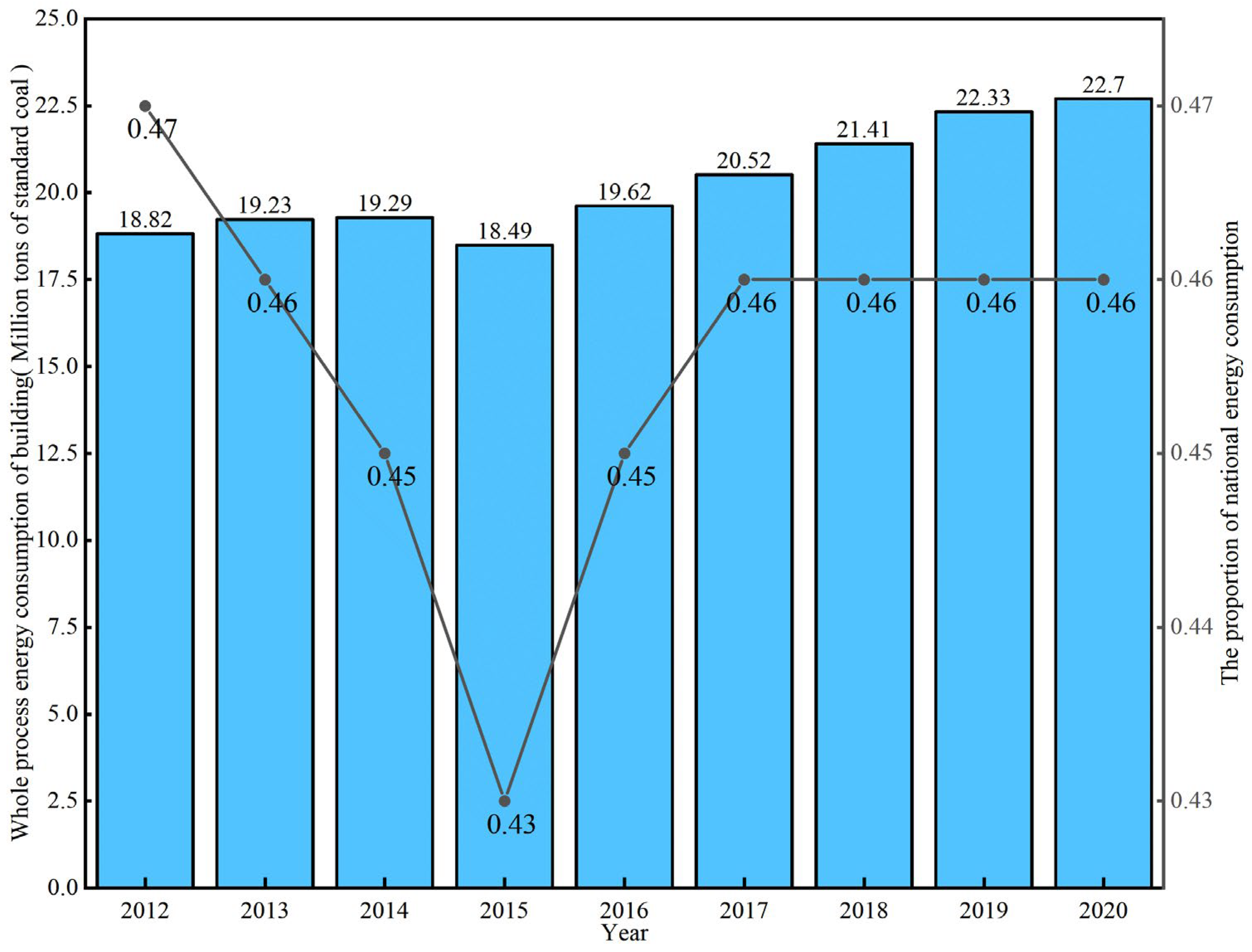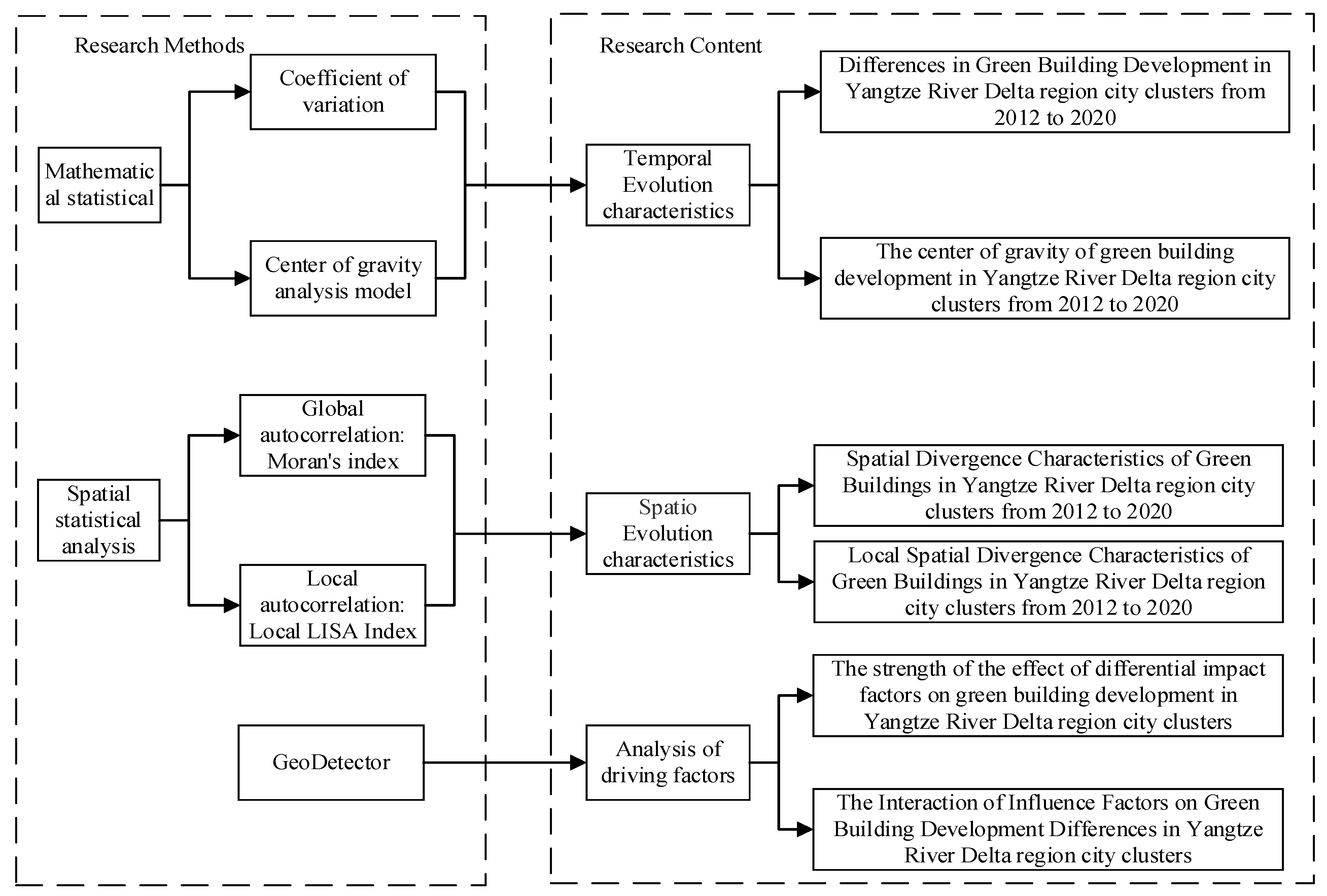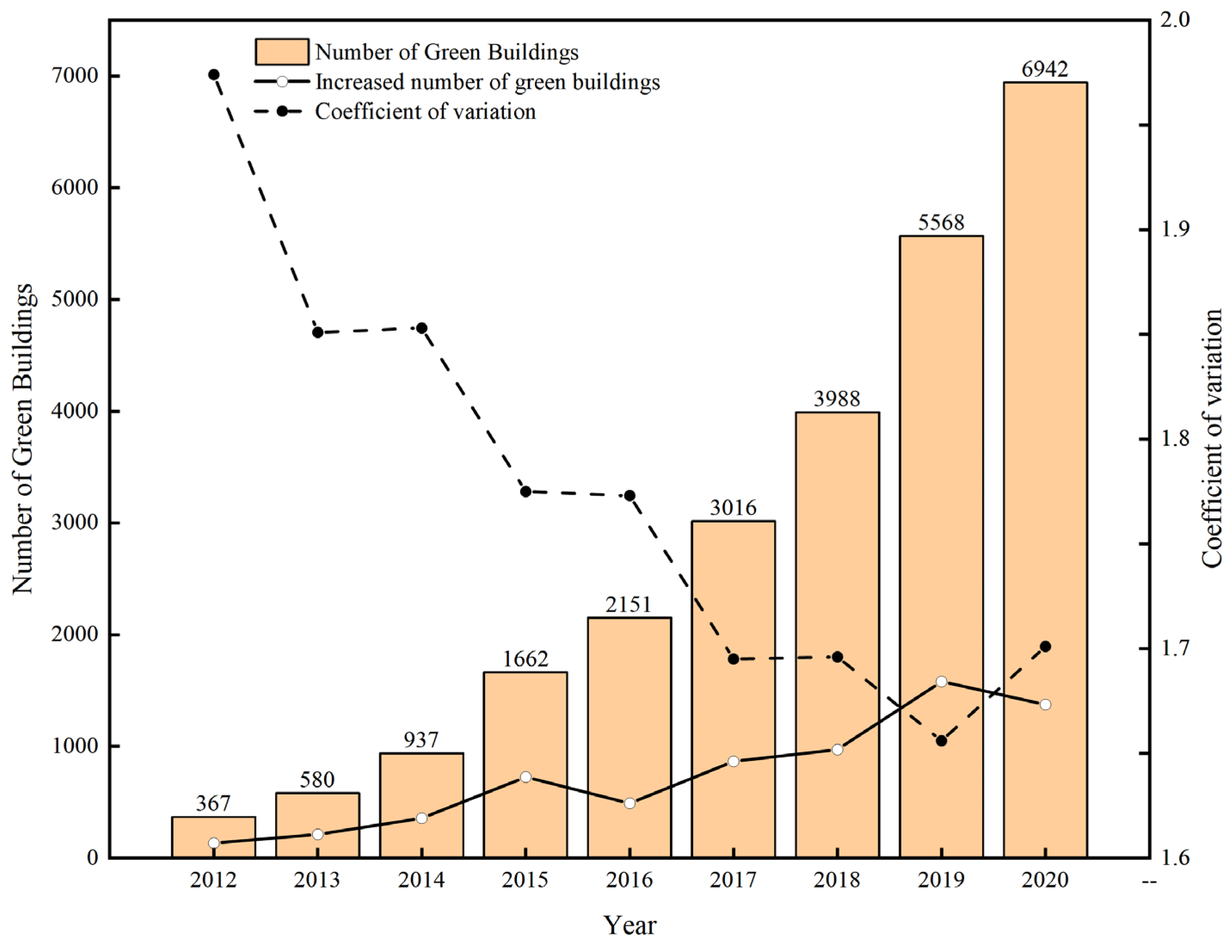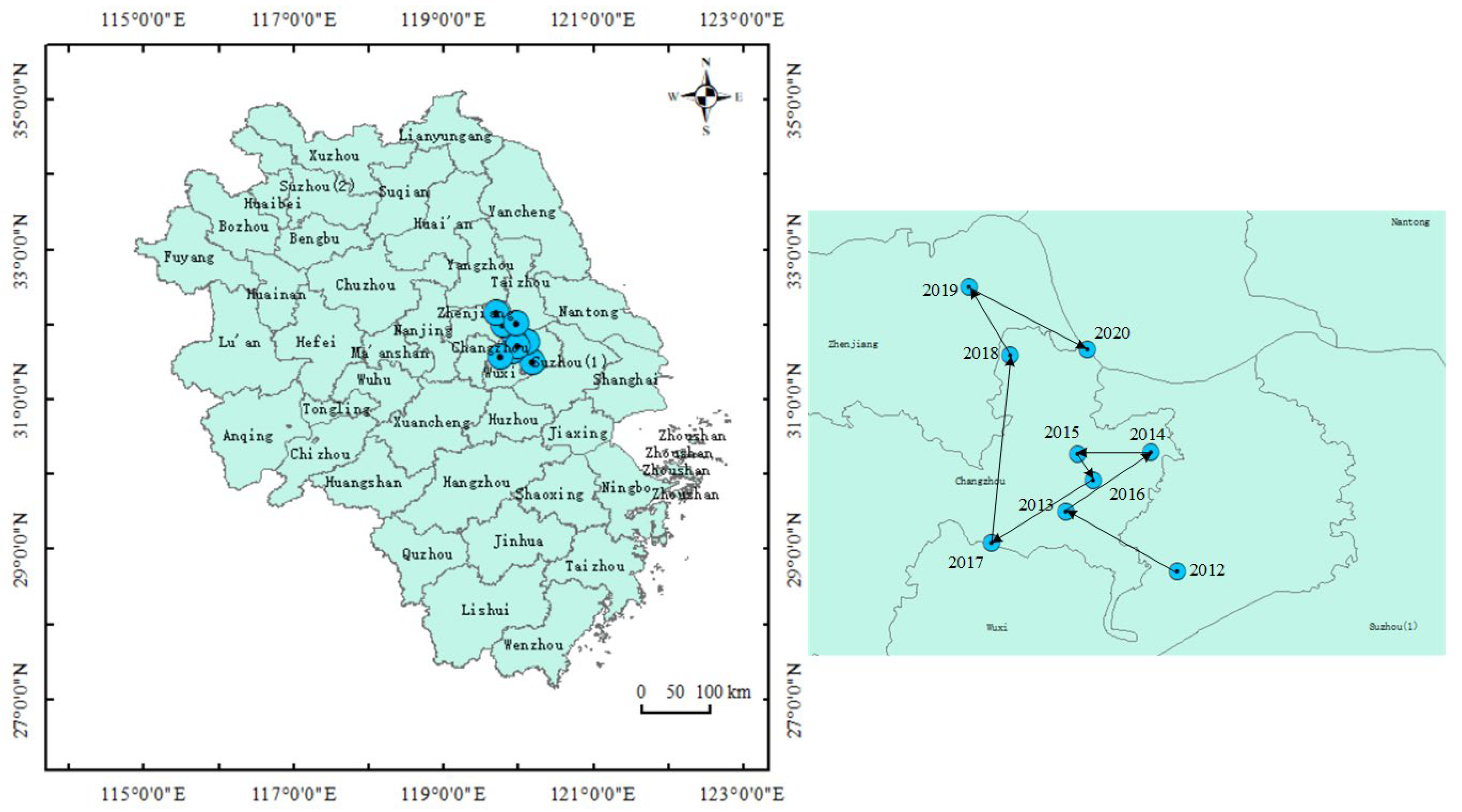Study on the Spatiotemporal Evolution Characteristics and Influencing Factors on Green Building Development of City Clusters in the Yangtze River Delta Region in China
Abstract
:1. Introduction
2. Materials and Methods
2.1. Research Objects
2.2. Data Sources
2.3. Research Methods
2.3.1. Mathematical Statistical Analysis
- (1)
- Coefficient of variation
- (2)
- Center of gravity analysis model
2.3.2. Spatial Statistical Analysis
- (1)
- Moran’s index (Moran’s I)
- (2)
- Local LISA Index
2.3.3. GeoDetector
3. Results
3.1. GB Distribution Pattern of YRD Region City Clusters
3.1.1. GB Year-by-Year Development Level
3.1.2. Distribution of GB Development in YRD Region City Clusters by City
3.1.3. Spatial Differentiation of GBs in the YRD Region City Clusters
3.2. Impact Analysis of GB Increment in the YRD Region City Clusters
3.2.1. Selection of Influence Factors
3.2.2. Analysis of Factor Detection Results
- (1)
- Single Factor Analysis
- (2)
- Two-Factor Interaction Analysis
4. Discussion
5. Conclusions
- (1)
- The number of GBs in the YRD region city clusters group is growing year by year, but the spatial difference in GB development is significant, and the overall pattern is “strong in the north and weak in the south; strong in the east and weak in the west”. The cities with low levels of GB development should connect GB development with economic development, pay attention to regional policies, and use their regional advantages to promote GBs. Cities with higher levels of GB development should break through the GB technology developed, establish GB demonstration bases, and promote the development of GBs in the direction of intelligence and architecture.
- (2)
- The development of GBs is spatially positively correlated, showing a high aggregation pattern and obvious polarization phenomenon, gradually forming a Shanghai–Suzhou (1)–Wuxi chain radiation zone. The clustering results show that the YRD urban agglomeration lacks an H-H spatial autocorrelation distribution pattern except for the core cities, and there are several L-L spatial autocorrelation regions, indicating that the core cities have strong attraction ability but relatively low radiation ability. Therefore, the planning and construction of ecological cities should not only pay attention to their elemental conditions but also make full use of the geographical conditions, such as the regional characteristics of those areas where GB development is concentrated. The cities with high levels of GB development are used as the centers to radiate the surrounding cities, drive the development of the surrounding cities, strengthen the exchange activities of eco-city construction between regions, expand the scope and intensity of GB development, and realize leapfrog development.
- (3)
- The main driving factors of the spatial differentiation pattern of GB development in the YRD region city clusters are education level, technical level, and gross domestic product. In order to break the uneven development of GBs, cities with lower levels of GB development should focus on the following measures: improve education level and enhance consumers’ awareness of green and low-carbon; actively strengthen technical investment in GB and integrate new technologies into the development of GBs; and promote economic development and stimulate the willingness of real estate companies to develop GBs.
- (1)
- The government should pay great attention to the spatiotemporal distribution pattern of GBs and introduce differentiated regulation policies according to their development status.
- (2)
- Introduce advanced GB technologies according to local conditions.
- (3)
- Establish a GB information sharing and exchange mechanisms to promote information sharing and exchange among cities. The cities with lower levels of green development can learn from the development mode of cities with higher levels.
- (4)
- Each city should combine its resource advantages, reasonably allocate resources, and focus on the synergistic development of each region.
- (5)
- Cities that invest too much in redundancy need to increase their talent pool and improve their innovation capacity and resource allocation efficiency.
Author Contributions
Funding
Institutional Review Board Statement
Informed Consent Statement
Data Availability Statement
Conflicts of Interest
References
- Dong, R. International Energy Agency: Analysis of Global Carbon Dioxide Emissions in 2022. China Electr. Enterp. Manag. 2023, 7, 94–95. [Google Scholar]
- Zhang, K.; Lu, Y.M.; Lu, H.S. Countermeasures for High Quality Development of Green Buildings in China under the Background of “Double Carbon” Goal. Constr. Econom. 2022, 43, 14–20. [Google Scholar] [CrossRef]
- Ye, Z.D. The Geography of Green Buildings in Chinese Cities. Mod. Urban Res. 2012, 27, 42–48. [Google Scholar]
- Wang, B.; Liao, F.W.; Zhang, J.Q. Evolutionary Game and Simulation of Key Subjects in Green Building Development. J. Technol. Econom. Manag. 2021, 7, 109–114. [Google Scholar]
- GB/T 50378-2019; Green Building Evaluation Standard. National Standards of the People’s Republic of China: Beijing, China, 2019.
- Qiao, W.; Dong, P.; Ju, Y. Synergistic development of green building market under government guidance: A case study of Tianjin, China. J. Clean. Prod. 2022, 340, 130540. [Google Scholar] [CrossRef]
- Chen, L.; Chan, A.P.; Darko, A.; Gao, X. Spatial-temporal investigation of green building promotion efficiency: The case of China. J. Clean. Prod. 2022, 362, 132299. [Google Scholar] [CrossRef]
- Zhao, H.; Xu, N.; Li, F. Research on development level of urban green building industry: A case study of Shandong Province. J. Shandong Jianzhu Univ. 2018, 33, 22–28. [Google Scholar]
- Gao, Y.; Yang, G.; Xie, Q. Spatial-Temporal Evolution and Driving Factors of Green Building Development in China. Sustainability 2020, 12, 2773. [Google Scholar] [CrossRef] [Green Version]
- Qiu, Y.; Tiwari, A.; Wang, Y.D. The diffusion of voluntary green building certification: A spatial approach. Energy Effic. 2014, 8, 449–471. [Google Scholar] [CrossRef]
- Cidell, J. Building Green: The Emerging Geography of LEED-Certified Buildings and Professionals. Prof. Geogr. 2009, 61, 200–215. [Google Scholar] [CrossRef]
- Kaza, N.; Lester, T.W.; Rodriguez, D.A. The Spatio-temporal Clustering of Green Buildings in the United States. Urban Stud. 2013, 50, 3262–3282. [Google Scholar] [CrossRef]
- Kahn, M.E.; Vaughn, R.K. Green Market Geography: The Spatial Clustering of Hybrid Vehicles and LEED Registered Buildings. BE J. Econ. Anal. Policy 2009, 9, 2030. [Google Scholar] [CrossRef]
- Guo, K.; Yuan, Y. Geographic Distribution and Influencing Factor Analysis of Green Residential Buildings in China. Sustainability 2021, 13, 12060. [Google Scholar] [CrossRef]
- Li, D.H. Regional Differences among the Development Models of Green Buildings in China—Based on statistical data from 2006 to 2014. Hous. Sci. 2019, 39, 35–43. [Google Scholar]
- Zhang, B.; Zhong, M. Measuring the Development Level and Temporal-Spatial Evolution Characteristics of Green Buildings. J. Eng. Manag. 2022, 36, 80–85. [Google Scholar] [CrossRef]
- Qiu, B.X.; Li, D.H.; Wu, Z.Q. Study on the Character of Chinese Green Building Spatial Evolution. Urban Dev. Stud. 2017, 24, 1–10. [Google Scholar]
- Liu, X.J.; Li, P. Spatial and Temporal Evolution and Driving Mechanism of Green Building Area in China. Ecol. Econ. 2021, 37, 88–94, 142. [Google Scholar]
- Zhang, S.S.; Liu, C.X.; Zhou, H. The Influence Factors Analysis of Green Building Development Based on Fuzzy Clustering: Taking Shenyang as an Example. J. Shenyang Jianzhu Univ. 2016, 18, 162–168. [Google Scholar]
- Guo, K.; Yuan, Y. Research on Spatial and Temporal Evolution Trends and Driving Factors of Green Residences in China Based on Weighted Standard Deviational Ellipse and Panel Tobit Model. Appl. Sci. 2022, 12, 8788. [Google Scholar] [CrossRef]
- Wang, J.; Xu, C. Geodetector: Principle and prospective. Acta Geogr. Sin. 2017, 73, 219–231. [Google Scholar]
- Liu, K.; Xue, Y.; Chen, Z.; Myao, Y. The spatiotemporal evolution and influencing factors of urban green innovation in China. Sci. Total Environ. 2023, 857, 159426. [Google Scholar] [CrossRef]
- GB/T 50378-2014; Green Building Evaluation Standard. National Standards of the People’s Republic of China: Beijing, China, 2014.
- Zou, Y.H.; Zhao, W.X.; Zhong, R.J. The spatial distribution of green buildings in China: Regional imbalance, economic funda-mentals, and policy incentives. Appl. Geogr. 2017, 88, 38–47. [Google Scholar] [CrossRef]
- Cidell, J.; Cope, M.A. Factors explaining the adoption and impact of LEED-based green building policies at the municipal level. J. Environ. Plan. Manag. 2013, 57, 1763–1781. [Google Scholar] [CrossRef]
- Zhang, Y.; Kang, J.; Jin, H.; Zhang, Y. Influencing Factors of the Development of Green Building by Designers Based on Grounded Theory. Int. J. Struct. Civ. Eng. Res. 2022, 11, 35–41. [Google Scholar] [CrossRef]
- Braun, T.; Cajias, M.; Hohenstatt, R. Societal Influence on Diffusion of Green Buildings: A Count Regression Approach. J. Real Estate Res. 2017, 39, 1–38. [Google Scholar] [CrossRef]
- Kok, N.; McGraw, M.; Quigley, J.M. The Diffusion of Energy Efficiency in Building. Am. Econ. Rev. 2011, 101, 77–82. [Google Scholar] [CrossRef] [Green Version]
- Kontokosta, C. Greening the Regulatory Landscape: The Spatial and Temporal Diffusion of Green Building Policies in U. S. Cities. J. Sustain. Real Estate 2011, 3, 68–90. [Google Scholar] [CrossRef]
- Li, G.; Ma, X.; Song, Y. Green Building Efficiency and Influencing Factors of Transportation Infrastructure in China: Based on Three-Stage Super-Efficiency SBM–DEA and Tobit Models. Buildings 2022, 12, 623. [Google Scholar] [CrossRef]
- Dong, S.X.; Liu, Y.M. Promotion Strategy of Green Building Large-scale Development Based on System Dynamics. J. Eng. Manag. 2013, 27, 16–20. [Google Scholar]
- Hu, W.F.; Kong, D.L.; He, X.H. Analysis on Influencing Factors of Green Building Development Based on BP-WINGS. Soft Sci. 2020, 34, 75–81. [Google Scholar]
- Zhou, Q.; Wang, H.P.; Xue, H.Y. A Study of the Driving Mechanism for Green Building Development in China. J. Xi’an Univ. Archit. Technol. 2019, 38, 28–38. [Google Scholar] [CrossRef]
- Song, Y.; Li, C.; Zhou, L.; Huang, X.; Chen, Y.; Zhang, H. Factors affecting green building development at the municipal level: A cross-sectional study in China. Energy Build. 2020, 231, 110560. [Google Scholar] [CrossRef]
- Chen, L.W.; Zhao, S.H.; Zhang, Z.J. Research on Related Drivers for GreenBuilding Development—A Literature Review. Resour. Dev. Mark. 2018, 34, 1229–1236. [Google Scholar] [CrossRef]
- Zhu, W.X.; Dai, J.F.; Chen, Y. Research on the dynamic evolution model and simulation of green construction technology innovation in construction enterprises. J. Chang. Univ. Sci. Technol. 2023, 20, 1–10. [Google Scholar]
- Zhu, W.X.; Zhang, J.; Wang, D.; Ma, C.; Zhang, J.; Chen, P. Study on the Critical Factors Influencing High-Quality Development of Green Buildings for Carbon Peaking and Carbon Neutrality Goals of China. Sustainability 2023, 15, 5035. [Google Scholar] [CrossRef]
- Miao, W.Y. Study on the spatial and temporal patterns of green development efficiency in the Yangtze River Delta urban ag-glomeration–an empirical investigation based on 41 cities in the Yangtze River Delta region from 2006 to 2020. China Arab. Sci. Technol. Forum 2023, 5, 18–22. [Google Scholar]












| Data Type | Unit | Data Sources | Update Frequency | Spatiotemporal Scales | |
|---|---|---|---|---|---|
| GB data | Number of GBs | Ind | Green Building Evaluation Marking Network, Provincial and Municipal Housing and Urban–rural Construction Departments | Real-time update | Year |
| Influencing factor data | Gross Domestic Product | Billion | Provincial and Municipal Statistical Yearbooks | Annual | |
| Disposable income per capita | Yuan | ||||
| Urbanization rate | None | ||||
| Education level | Ten thousand persons | ||||
| Real estate development level | Billion | ||||
| Technology development level | Pieces | ||||
| Industry scale | Door | ||||
| Related guiding policies | Band | ||||
| Level of importance | None | ||||
| The primary energy supply rate | Billion cubic meters | ||||
| Natural environment | Meter | ||||
| Publicity efforts | Part | Thematic Full-text Database of China’s important Newspapers | Real-time update | ||
| Judgment | Interaction |
|---|---|
| q(X1 ∩ X2) < Min(q(X1), q(X2)) | Nonlinear weakening |
| Min(q(X1), q(X2)) < q(X1 ∩ X2) < Max(q(X1), q(X2)) | Single-factor nonlinear weakening |
| q(X1 ∩ X2) > Max(q(X1), q(X2)) | Two-factor enhancement |
| q(X1 ∩ X2) = q(X1) + q(X2) | Independent |
| q(X1 ∩ X2) > q(X1) + q(X2) | Nonlinear enhancement |
| Dimension | Influence Factors | Explanation | References |
|---|---|---|---|
| Population and Economy | Gross Domestic Product (GDP) X1 | Total final production of all resident units in the YRD region during a given period | Zou et al. [24], Cidell et al. [25], and Zhang et al. [26] |
| Disposable income per capita X2 | Discretionary income available to residents | Braun et al. [27], Kok [28], and Kontokosta [29] | |
| Urbanization rate X3 | The proportion of resident population in cities and towns to total population in the YRD region | Zhang et al. [16] and Li et al. [30] | |
| Education level X4 | The average number of college students per 10,000 population | Guo et al. [14] | |
| Market Environment | Real estate development level X5 | Investment in real estate development | Dong et al. [31] and Zhang et al. [26] |
| Technology development level X6 | Granted patent | Hu et al. [32], Zhou et al. [33], and Zhang et al. [26] | |
| Industry scale X7 | Number of construction enterprises | Zhang et al. [16] | |
| Policy | Related guiding policies X8 | GB-Related Policies | Cidell et al. [25], Song et al. [34], and Chen et al. [35] |
| Level of importance X9 | Proportion of expenditure on energy saving and environmental protection in public expenditure | Hu et al. [32], Zhang et al. [26], and Zhu et al. [36] | |
| Other Factors | The primary energy supply rate X10 | Total water resources | Guo et al. [14] |
| Natural environment X11 | Average altitude | Kontokosta [29] and Braun et al. [27] | |
| Publicity efforts X12 | Number of special reports by mainstream media | Kontokosta [29], Zhang et al. [26], and Zhu et al. [37] |
| Year | X1 | X2 | X3 | X4 | X5 | X6 | X7 | X8 | X9 | X10 | X11 | X12 |
|---|---|---|---|---|---|---|---|---|---|---|---|---|
| 2012 | 0.6518 | 0.5332 | 0.6403 | 0.5537 | 0.4064 | 0.7277 | 0.7147 | 0.0007 | 0.3465 | 0.4263 | 0.2208 | 0.5332 |
| 2016 | 0.7370 | 0.4985 | 0.6823 | 0.6222 | 0.4733 | 0.6389 | 0.6517 | 0.1051 | 0.1021 | 0.5171 | 0.4424 | 0.3140 |
| 2020 | 0.4386 | 0.3208 | 0.3598 | 0.8208 | 0.1169 | 0.5142 | 0.3549 | 0.0011 | 0.1536 | 0.4115 | 0.6161 | 0.5679 |
| Explanatory power mean | 0.6091 | 0.4508 | 0.5608 | 0.6656 | 0.3322 | 0.6269 | 0.5738 | 0.0356 | 0.2008 | 0.4516 | 0.4264 | 0.4717 |
| Interaction Type | 2012 | 2016 | 2020 | Interaction Type | 2012 | 2016 | 2020 | Interaction Type | 2012 | 2016 | 2020 |
|---|---|---|---|---|---|---|---|---|---|---|---|
| X1 ∩ X2 | 0.7399 * | 0.9702 * | 0.8705 ** | X3 ∩ X5 | 0.9200 * | 0.8974 * | 0.7388 ** | X5 ∩ X12 | 0.6799 * | 0.7449 * | 0.7905 ** |
| X1 ∩ X3 | 0.7743 * | 0.8411 * | 0.7501 * | X3 ∩ X6 | 0.8886 * | 0.8420 * | 0.7712 * | X6 ∩ X7 | 0.8318 * | 0.7828 * | 0.6910 * |
| X1 ∩ X4 | 0.8265 * | 0.9425 * | 0.9569 * | X3 ∩ X7 | 0.8481 * | 0.8331 * | 0.8226 ** | X6 ∩ X8 | 0.7279 * | 0.8337 ** | 0.5146 * |
| X1 ∩ X5 | 0.8107 * | 0.9079 * | 0.8871 ** | X3 ∩ X8 | 0.6403 * | 0.8329 ** | 0.3612 * | X6 ∩ X9 | 0.8715 * | 0.8347 ** | 0.7288 ** |
| X1 ∩ X6 | 0.8967 * | 0.9362 * | 0.8121 * | X3 ∩ X9 | 0.7839 * | 0.7869 ** | 0.5234 ** | X6 ∩ X10 | 0.8787 * | 0.9207 * | 0.8385 * |
| X1 ∩ X7 | 0.8443 * | 0.7526 * | 0.5979 * | X3 ∩ X10 | 0.9639 * | 0.9493 * | 0.8909 ** | X6 ∩ X11 | 0.8794 * | 0.9623 * | 0.9461 * |
| X1 ∩ X8 | 0.6519 * | 0.9010 ** | 0.4390 * | X3 ∩ X11 | 0.9248 ** | 0.9408 * | 0.9147 * | X6 ∩ X12 | 0.8726 * | 0.7722 * | 0.8304 * |
| X1 ∩ X9 | 0.9043 * | 0.8097 * | 0.6753 ** | X3 ∩ X12 | 0.7540 * | 0.8121 * | 0.8678 * | X7 ∩ X8 | 0.7148 * | 0.8488 ** | 0.3554 * |
| X1 ∩ X10 | 0.9490 * | 0.9499 * | 0.8011 * | X4 ∩ X5 | 0.7533 * | 0.8099 * | 0.9344 * | X7 ∩ X9 | 0.8855 * | 0.7953 ** | 0.6115 ** |
| X1 ∩ X11 | 0.9745 ** | 0.9457 * | 0.9229 * | X4 ∩ X6 | 0.8590 * | 0.8643 * | 0.9074 * | X7 ∩ X10 | 0.8771 * | 0.9334 * | 0.8467 ** |
| X1 ∩ X12 | 0.7172 * | 0.7822 * | 0.8855 * | X4 ∩ X7 | 0.8022 * | 0.9094 * | 0.9489 * | X7 ∩ X11 | 0.9082 * | 0.9108 * | 0.8578 * |
| X2 ∩ X3 | 0.8480 * | 0.9140 * | 0.7990 ** | X4 ∩ X8 | 0.5540 * | 0.7169 * | 0.8209 * | X7 ∩ X12 | 0.7709 * | 0.7429 * | 0.9103 * |
| X2 ∩ X4 | 0.8365 * | 0.8703 * | 0.9749 * | X4 ∩ X9 | 0.8997 * | 0.7757 ** | 0.8738 * | X8 ∩ X9 | 0.3468 * | 0.1527 * | 0.1558 ** |
| X2 ∩ X5 | 0.8116 * | 0.8583 * | 0.5663 ** | X4 ∩ X10 | 0.8056 * | 0.9254 * | 0.8958 * | X8 ∩ X10 | 0.4268 * | 0.5414 * | 0.4119 * |
| X2 ∩ X6 | 0.7588 * | 0.8469 * | 0.6781 * | X4 ∩ X11 | 0.9695 ** | 0.9707 * | 0.9686 * | X8 ∩ X11 | 0.2210 * | 0.5260 * | 0.6162 * |
| X2 ∩ X7 | 0.8088 * | 0.9243 * | 0.8740 ** | X4 ∩ X12 | 0.7352 * | 0.8242 * | 0.8379 * | X8 ∩ X12 | 0.4551 * | 0.5376 ** | 0.5682 * |
| X2 ∩ X8 | 0.5335 * | 0.6416 ** | 0.3215 * | X5 ∩ X6 | 0.8300 * | 0.8381 * | 0.5831 * | X9 ∩ X10 | 0.9436 ** | 0.8497 ** | 0.7326 ** |
| X2 ∩ X9 | 0.9056 ** | 0.7274 ** | 0.7309 ** | X5 ∩ X7 | 0.7873 * | 0.8477 * | 0.6593 ** | X9 ∩ X11 | 0.6593 ** | 0.6340 ** | 0.7247 * |
| X2 ∩ X10 | 0.9423 * | 0.9514 * | 0.9405 ** | X5 ∩ X8 | 0.4065 * | 0.5979 ** | 0.1179 * | X9 ∩ X12 | 0.6008 * | 0.3624 * | 0.7284 ** |
| X2 ∩ X11 | 0.9635 ** | 0.9686 ** | 0.9471 ** | X5 ∩ X9 | 0.7771 ** | 0.7860 ** | 0.5298 ** | X10 ∩ X11 | 0.9307 ** | 0.9405 * | 0.8058 * |
| X2 ∩ X12 | 0.7140 * | 0.6570 * | 0.8490 * | X5 ∩ X10 | 0.9463 ** | 0.9338 * | 0.7821 ** | X10 ∩ X12 | 0.8602 * | 0.6544 * | 0.6771 * |
| X3 ∩ X4 | 0.8791 * | 0.9219 * | 0.9106 * | X5 ∩ X11 | 0.9709 ** | 0.9254 ** | 0.9703 ** | X11 ∩ X12 | 0.5261 * | 0.6633 * | 0.7743 * |
Disclaimer/Publisher’s Note: The statements, opinions and data contained in all publications are solely those of the individual author(s) and contributor(s) and not of MDPI and/or the editor(s). MDPI and/or the editor(s) disclaim responsibility for any injury to people or property resulting from any ideas, methods, instructions or products referred to in the content. |
© 2023 by the authors. Licensee MDPI, Basel, Switzerland. This article is an open access article distributed under the terms and conditions of the Creative Commons Attribution (CC BY) license (https://creativecommons.org/licenses/by/4.0/).
Share and Cite
Zhu, W.; Zhang, J.; Dai, J.; Wang, D.; Ma, C.; Xu, Y.; Chen, Y. Study on the Spatiotemporal Evolution Characteristics and Influencing Factors on Green Building Development of City Clusters in the Yangtze River Delta Region in China. Sustainability 2023, 15, 9457. https://doi.org/10.3390/su15129457
Zhu W, Zhang J, Dai J, Wang D, Ma C, Xu Y, Chen Y. Study on the Spatiotemporal Evolution Characteristics and Influencing Factors on Green Building Development of City Clusters in the Yangtze River Delta Region in China. Sustainability. 2023; 15(12):9457. https://doi.org/10.3390/su15129457
Chicago/Turabian StyleZhu, Wenxi, Jing Zhang, Jinfei Dai, Da Wang, Chongsen Ma, Yufang Xu, and Yun Chen. 2023. "Study on the Spatiotemporal Evolution Characteristics and Influencing Factors on Green Building Development of City Clusters in the Yangtze River Delta Region in China" Sustainability 15, no. 12: 9457. https://doi.org/10.3390/su15129457





